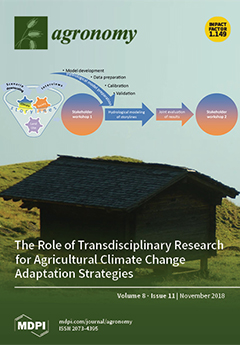1
Department of Environmental Sciences, University of California Riverside, 900 University Ave., Riverside, CA 92521, USA
2
USDA-ARS, United States Salinity Laboratory, 450 West Big Springs Rd., Riverside, CA 92507, USA
3
Department of Civil, Environmental, and Architectural Engineering (ICEA), University of Padua, Via Trieste 63, 35121 Padua, Italy
4
ETH Zurich, Department of Civil, Environmental and Geomatic Engineering, Stefano-Franscini-Platz 5, 8093 Zürich, Switzerland
5
Institute of Marine Sciences (ISMAR), National Research Council, Arsenale Tesa 104, Castello 2737/F, 30122 Venezia, Italy
6
Department of Agronomy, Food, Natural resources, Animals, and Environment (DAFNAE), University of Padua, Viale dell’Università 16, 35020 Legnaro, Italy
Abstract
Management zones (MZs) are used in precision agriculture to diversify agronomic management across a field. According to current common practices, MZs are often spatially static: they are developed once and used thereafter. However, the soil–plant relationship often varies over time and space, decreasing
[...] Read more.
Management zones (MZs) are used in precision agriculture to diversify agronomic management across a field. According to current common practices, MZs are often spatially static: they are developed once and used thereafter. However, the soil–plant relationship often varies over time and space, decreasing the efficiency of static MZ designs. Therefore, we propose a novel workflow for time-specific MZ delineation based on integration of plant and soil sensing data. The workflow includes four steps: (1) geospatial sensor measurements are used to describe soil spatial variability and in-season plant growth status; (2) moving-window regression modelling is used to characterize the sub-field changes of the soil–plant relationship; (3) soil information and sub-field indicator(s) of the soil–plant relationship (i.e., the local regression slope coefficient[s]) are used to delineate time-specific MZs using fuzzy cluster analysis; and (4) MZ delineation is evaluated and interpreted. We illustrate the workflow with an idealized, yet realistic, example using synthetic data and with an experimental example from a 21-ha maize field in Italy using two years of maize growth, soil apparent electrical conductivity and normalized difference vegetation index (NDVI) data. In both examples, the MZs were characterized by unique combinations of soil properties and soil–plant relationships. The proposed approach provides an opportunity to address the spatiotemporal nature of changes in crop genetics × environment × management interactions.
Full article





